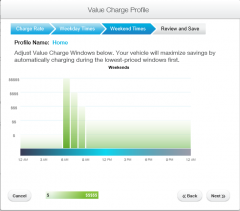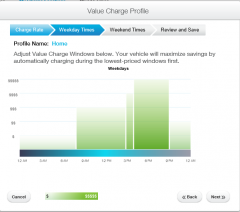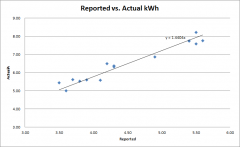

larryh
Fusion Energi Member-
Posts
1,462 -
Joined
-
Last visited
-
Days Won
152
Content Type
Gallery
Profiles
Forums
Everything posted by larryh
-

Reported Trip Energy Used vs Energy required to recharge car
larryh replied to larryh's topic in Lounge - Fusion Energi
Yes, that battery was depleted. I drove 56.5 total miles on Freeway/Highway. The first 24.4 miles were in EV mode after which the battery was depleted and the ICE turned on. The car then consumed 0.73 gallons of gas during the remainder of the trip. The car claimed to have used 5.6 kWh of charge from the battery. It required 7.75 kWh to recharge the battery. Actually, that was one of the more efficient trips. The efficiency was then 5.6 / 7.75 = 72%. I got 72% of the electrical energy put into the car as work to propel it. -
When setting up the Value Charge Profiles in MFM, is there anyway to delete some of the windows that determine the charge times? There are five windows. Unless you choose different heights/priorities for each window, MFM will do it for you (and you will probably not like the heights/priorities that it chose). So you are forced to select five different charge time windows and prioritize them with distinct priorities. Here is the weekday profile that I set up: There are actually three different rates charged by the Electric Company during the weekday. The lowest rate is from 9:00 pm to 8:00 am. The next lowest rate is from 8:00 am to 4:00 pm. The outlandishly exorbitant rate is from 4:00 pm to 9:00 pm. So I have to arrange and prioritize five different windows that represent these different rates. I can't make a window from 9:00 pm to 8:00 am because the left side of the screen starts at 12:00 am, and not 9:00 pm. So I am forced to split 9:00 pm to 8:00 am into two different windows with different priorities (even though the rate is the same for both windows). Next, since I can't delete a window, I have to split 8:00 am to 4:00 pm into two windows with different rates. Finally, I have the extortionate rate from 4:00 to 9:00 pm with the lowest priority (highest cost). Under no circumstances do I want the car to charge at these times. Unfortunately, MFM doesn't work that way. It uses 60 watts of electricity during this time to charge the 12-volt battery and power the control module for the battery that will later initiate the charging (wiping out the savings I would have under this rate plan from the Electric Company). For the weekend, the rate is constant. I am forced to create the following Value Charge Profile: I need only one window. But I am forced to create four additional ones. And of course, each window has to have a different priority.
-
From the album: Car
-
From the album: Car
-

Reported Trip Energy Used vs Energy required to recharge car
larryh replied to larryh's topic in Lounge - Fusion Energi
The Kill A Watt meter seems to be accurate. The current when charging is 11.52 amps and the power is 1355 watts. The last full charge for a depleted battery took 5 hours and 47 minutes. Multiply that by 1355 watts and I get 7.84 kWh. Since the charge tapers off at the end, the actual energy consumed to charge the battery was 7.75 kWh. Note the maximum rated amperage of the charger supplied with the car is 12 amps. -
You can use one of the trip odometers to record MPG in hybrid mode. Wait until the car enters hybrid mode after the battery has depleted and then reset the trip odometer. It will keep track of the fuel used along with the miles driven. Enjoy your new car and trip.
-

Reported Trip Energy Used vs Energy required to recharge car
larryh replied to larryh's topic in Lounge - Fusion Energi
I see in Scooter80's review of the 240 V GE Wattstation, charging a fully depleted battery required 6.8 and 6.9 kWh (vs. 7.8 kWh for the 120 V charger). So that provides more evidence that a 240V charger is more efficient. -
This is all I see in the manual: BREAKING-IN You need to break in new tires for approximately 300 miles (480 kilometers). During this time, your vehicle may exhibit some unusual driving characteristics. The engine also needs to break in. Avoid hard accelerations and driving too fast for the first 1000 miles (1600 kilometers). If possible, avoid carrying heavy loads up steep grades during the break-in period.
-
I told my dealer about the prices for the ESP plan available via the internet. They didn't want to match that price and wanted to sell me a different one from Wells Fargo. That plan had different prices for the different models. There are multiple dealers available on the internet that you can select from to buy the Ford ESP.
-
The Ford ESP has only one rate for all models of the Fusion. That includes the gas, hybrid and Energi models. You are selecting the correct drop down box when choosing fusion/flex inc. hybrid. Your dealer is misinforming you if they told you that there are different rates for the hybrid vs the Energi.
-
I purchased from Anderson and Koch. The rates are the same for all models of the Fusion.
-
After you accept the second confirmation message regarding MFM on the MyFord Touch screen in the car. You should receive the second confirmation message about 24 hours after the first one (which you should have received soon after you registered with MFM).
-

Reported Trip Energy Used vs Energy required to recharge car
larryh replied to larryh's topic in Lounge - Fusion Energi
I wonder if the car just measures the energy used to power the wheels. So the losses associated with charging the vehicle and converting the battery charge to mechanical energy are not taken into account. Hence I put in 7.8 kWh of energy and only get 5.6 kWh of useful work out. -

Reported Trip Energy Used vs Energy required to recharge car
larryh replied to larryh's topic in Lounge - Fusion Energi
The MPGe computation is supposed to include power from wall to wheel: EPA's miles per gallon equivalent metric MPGe is determined in a manner similar to MPG for a conventional internal combustion engine vehicle. In both cases the metric only considers the pump-to-wheel or wall-to-wheel energy consumption, i.e. it measures the energy for which the owner usually pays. For EVs the energy cost includes the conversion from AC from the wall used to charge the battery. The MPGe computed by the car is missing the energy losses associated with conversion from AC from the wall to charge the battery. So what the car is reporting cannot be compared to the EPA rating on the window sticker. Note that the EPA ratings do not account for the energy consumption upstream, which includes the energy or fuel required to generate the electricity or to extract and produce gasoline; the energy losses due to power transmission; or the energy consumed for the transportation of the fuel from the well to the station. -

Reported Trip Energy Used vs Energy required to recharge car
larryh replied to larryh's topic in Lounge - Fusion Energi
For the 120 volt charger, the minimum amount I have recorded to charge the battery after it has been depleted is 7.57 kWh. The maximum is 8.21 kWh. The 240 volt charger could possibly be more efficient. So that would imply that the true MPGe values for the car depends upon the charger being used. I wonder what charger the EPA used to rate the car? -

Reported Trip Energy Used vs Energy required to recharge car
larryh replied to larryh's topic in Lounge - Fusion Energi
My commute is city streets at 55 mph, so I won't get the best MPGe numbers. I generally get better numbers in the morning when its in the 60's rather than my commute home in the 70's. Probably, because there is much less traffic in the morning vs. the afternoon commute home so I have more control over how I drive (the other drivers are not forcing me to be inefficient, i.e. more room for braking, etc.). The 60 watts of energy prior to the value charge time is used to slowly charge the battery. I have asked Ford why it is doing this, but I have not yet received a response. It should not use any energy until the value charge time. After the battery is fully charged, the charger consumes a minimal 1.8 Watts of energy waiting for the next charge. I will be getting a 240V charger next month and a submeter from the electric company, so I will find out if it is any better then. Note that the actual charging efficiency varies significantly. The multiplier factor varies from a minimum of 1.36 (the value you computed above) to a maximum of 1.55 over the two week period. The average was 1.44. I have no idea why it varies so much. -

Reported Trip Energy Used vs Energy required to recharge car
larryh replied to larryh's topic in Lounge - Fusion Energi
The EPA uses 33.7 kilowatt-hours (33,705 watts) of electricity equivalent to one gallon of gas. That is also the number used at the Wikipedia link: , where wall-to-wheel electrical energy consumed (Wh per mile). The 1.44 is from the plot in the first post. The amount of energy required to charge the car is 1.44 times the amount of energy reported by the Trip Summary/Odometer or MyFord Mobile. Basically, I can conclude from the chart, that the MPGe reported by the Trip Summary/Odometer/MFM must be divided by 1.44 to determine the true MPGe. I believe the EPA computes MPGe as follows: "The EPA fully charges an EV and then lets it sit overnight. The following day the vehicle is driven through successive test cycles until it is no longer able to perform the test cycle. Then the vehicle is brought back to a fully charged state, and the energy used to recharge the vehicle is measured at the wall because that is the energy usage that will appear on the consumer's utility bill." -

Reported Trip Energy Used vs Energy required to recharge car
larryh replied to larryh's topic in Lounge - Fusion Energi
If I look at my commute to and from work on Monday of 15.5 miles, as reported by the trip odometer, the car consumed 3.5 kWh. So my MPGe for that trip, using this value, was (15.5/3.5)*33.7 = 149 MPGe (which matches what I see at the MyFord Mobile web site). However, the true energy consumed was approximately 3.5*1.44 = 5.04 kWh. (The actual amount was 5.44 which is much more than normal for some reason). Using the correct energy consumption, the mileage was actually (15.5/5.04)*33.7 = 104 MPGe. So, rather than substantially exceeding the EPA ratings, I am actually only just matching them. The MPGe shown on the console and at the MyFord Mobile web site make the car look like it is getting much better MPGe than it really is. Note that the amount of energy to charge the car (for the same amount of battery depletion) varies considerably from day to day for some reason. So I am not sure how to properly measure the amount of energy required to recharge the car when computing MPGe. -

Reported Trip Energy Used vs Energy required to recharge car
larryh replied to larryh's topic in Lounge - Fusion Energi
Note that this would imply that the MPGe values shown on the console are overly optimistic. The true MPGe is probably lower. -
For the past two weeks, I have been keeping track of the total amount of energy consumed as reported in the Trip Summary/Odometer vs. how much energy is required to recharge the battery using a Kill A Watt electricity usage meter. I reset the trip odometer with a fully charged battery at the start of the day. Then when I arrive home to recharge, I keep track of the energy with the Kill A Watt meter required to fully recharge the battery. I do not include the energy required for pre-conditioning the car. The following plots the results: I suspect the car is under reporting the energy consumed. The battery holds 7.6 kWh, of which, 1.1 kWh is reserved for hybrid use. So if I deplete the battery, I would expect that I would have used at least 6.5 kWh of energy. The most the trip odometer shows that I have consumed is 5.6 kWh. Of course, the charging process is not 100% efficient. Some of the energy used to charge the battery is wasted as heat or used to power the cooling fans for the battery. So I would expect it to take a bit more than 6.5 kWh to charge. According to the plot above, the amount of electricity required to power the car is under reported by about 44%. For a fully depleted battery, it requires about 7.8 kWh. I wonder if the results would differ with a 240 volt charging station. I am using the 120 volt charger that came with the car. I also wonder if the current outside temperature makes a difference. I need to redo this chart. I set the charging to "Value Charge" for several of the charges. Value Charge consumes 60 watts of power while waiting to charge. So, if the car waited 10 hours to charge, the measured energy to charge the battery will be off by 0.6 kWh. "Charge Now" will use less electricity to charge the car.
-
From the album: Car
kWh reported by trip summary/odometer vs. kWh required to recharge the battery (measured with a kill a watt electricity usage meter). -
The trip issues appear to have been fixed except for one. There is a trip with incorrect mileage (negative 0.7 miles when it should be more like 56.5 miles).
-
The Trip & Charge log has a lot of useful information. It would also be nice if it also showed the amount of gasoline in the tank before and after the start of a trip as well as the gas consumed. It shows charging information. It would be nice if it would also show fueling information for gasoline. Unfortunately, many of the trips shown seem to be inaccurate. The number of miles driven is incorrect (some are even negative). There are duplicate trips. And also, some of the trips are split into multiple trips--I did not make any stops during those trips.
-
See the following thread: http://www.fordfusionenergiforum.com/topic/1016-new-myford-mobile-release/ They only updated the MyFord Mobile web site. The apps have not yet been updated. I unplugged the car at my alternate home. I haven't tried it at my primary home.
-
With the new version of MyFord Mobile, I received an unplugged notification today when I unplugged the car before it finished charging. This is the first time I have received a notification when I unplugged the car before it finished charging. 06/21/2013 10:49:36 AM Hello Larry, We thought you would like to know that Fusion Energi has experienced an accidental unplug while charging. Please plug Fusion Energi in for the charging to continue.


